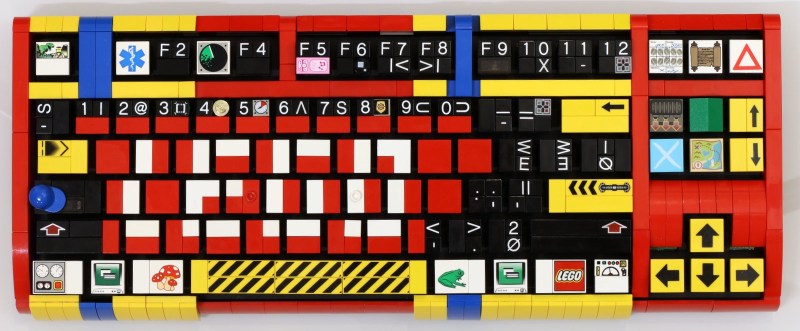As any good hacker (or scientist) knows, sometimes you find the tools you need in unexpected places. For one group of MIT scientists, that place is a box of Lego. Graduate student [Crystal Owens] was looking for new ways to make a cheap, simple microfluidics kit. This technique uses the flow of small amounts of liquid to do things like sort cells, test the purity of liquids and much more. The existing lab tools aren’t cheap, but [Crystal] realized that Lego could do the same thing. By cutting channels into the flat surface of a Lego brick with a precise CNC machine and covering the side of the brick with glass, she was able to create microfluidic tools like mixers, drop makers and others. To create a fluid resistor, she made the channel smaller. To create a larger microfluidic system, she mounted the blocks next to each other so the channels connected. The tiny gap between blocks (about 100 to 500 microns) was dealt with by adding an O-ring to the end of each of channel. Line up several of these bricks, and you have a complete microfluidic system in a few blocks, and a lab that only costs a few dollars.
LED Stand For Lego Saturn V Boldly Goes Where No Lego Has Gone Before
Hackers everywhere have spent the last couple of weeks building the remarkable Saturn V Lego models that they got for the holidays, but [Kat & Asa Miller] decided to go an extra step for realism: they built a stand with LED lights to simulate launch. To get the real feel of blast off, they used pillow stuffing, a clear acrylic tube and a string of NeoPixel LEDs. These are driven by an Adafruit Trinket running code that [Asa] wrote to create the look of a majestic Saturn V just lifting off the launchpad with the appropriate fire and fury. They initially were not sure if the diminutive Trinket would have the oomph to drive the LEDs, but it seems to work fine, judging by the video that you can see after the break.
Continue reading “LED Stand For Lego Saturn V Boldly Goes Where No Lego Has Gone Before”
Connecting Cherry MX Key Switches To LEGO Just Got Easier

Here on Hackaday, we like keyboard hacks. Given how much time we all spend pounding away on them, they’re natural hacks to come up with. If you’re pulling the circuitry from an existing keyboard then chances are the keys are pressed either by pushing down on rubber domes (AKA the membrane type), or on mechanical switches. [Jason Allemann] has just made it easier to do keyboard hacks using LEGO by building one for a circuit board with mechanical Cherry MX key switches. That involved designing parts to connect LEGO bricks to the switches.
For those custom parts, he recruited his brother [Roman], who’s a mechanical engineer. [Roman] designed keycaps with a Cherry MX stem on one side for snapping onto the key switches, and LEGO studs on the other side for attaching the LEGO bricks. The pieces also have a hole in them for any keys which have LEDs. Of the 100 which [Jason] ordered from Shapeways, around ten were a bit of a loose fit for the LEGO bricks, but only if you were doing extreme button mashing would they come off.
The easy part was the keyboard circuit board itself, which he simply removed from an old Cooler Master Quick Fire Rapid keyboard and inserted into his own LEGO keyboard base.

We do like his creative use of bricks for the keys. For one thing, the letter keys have no letters on them and so is for toufh-typosts touch-typists only. The Caps Lock is a baseball cap, which would be awkward to press except that no one ever does anyway. ESC is a picture of a person running from a dinosaur and F1, which is often the help-key, is the Star of Life symbol for medical emergency services such as ambulances. Scroll Lock is, of course, a scroll. And to make himself type faster, he incorporated blue racing stripes into the frame, but you can judge for yourself whether or not that trick actually works by watching his detailed build-video below.
Continue reading “Connecting Cherry MX Key Switches To LEGO Just Got Easier”
Lego Go-Kart Scores Radio Control
LEGO has always been an excellent toy for both play and learning, and the Technic sets are a great starting point for any budding engineer. Not content to rest on their plastic, blocky laurels, LEGO introduced more advanced parts over the years, such as motors and battery packs to allow builders to propel their creations. Combine this mechanical philosophy with [Matt]’s Giant Lego Go-Kart and you have one heck of a project.
It all started months ago, when [Matt] built his original Giant Lego Go-Kart, a 5-times scaled up model of the original kit #1972-1. Achieved through the wonder of 3D printing, he had sized it up based off the largest parts he could fit on his printer. The Youtube video led to commenters asking – could it be driven?
He decided that radio control was definitely a possibility. Not content to simply bolt on a series of motors to control the drive and steering, he took the effort to build scaled up replica LEGO motors, even taking care to emulate the old-school connectors as well. A particularly nice touch was the LEGO antenna, concealing the Orange RX radio receiver.
There were some hiccups – at this scale & with [Matt]’s parts, the LEGO force just isn’t strong enough to hold everything together. With a handful of zipties and a few squirts of glue, however, the giant ‘kart was drifting around the carpark with ease and hitting up to 26km/h.
In the end, the build is impressive not just for its performance but the attention to detail in faithfully recreating the LEGO aesthetic. As for the next step, we’d like to know what you think – how could this be scaled up to take a human driver? Is it possible? You decide.
Freakishly Agile Crawler Rocks All-LEGO Mechanum Wheels
Mechanum wheels are great, but you have to have them perfectly alined or they come across a little clunky, giving your robot a herky-jerky movement. Robotics educator and supreme LEGO builder [Yoshihito Isogawa] built a mechanum-wheeled rover that has the angles right: each wheel consists of 12 smaller rubber tires angled at 45 degrees. The key to the project is Part Number 85940, accurately if unsexily named “double Ø4.85 hole w/ Ø3.2 shaft”. It consists of a double technic hole with a shaft projecting in a 45-degree angle.
Unlike his omni-roller project with 3 large wheels and the mechanum tank treads he built for another project, this one features the gold standard of mechanum movement: creepy agility. He also did a version with 9 side rollers per wheel, and it was nearly as stable.
Hackaday loves [Yoshihito]’s great creations, which are as beautiful and elegant as they are functional. His all-LEGO centrifugal pump and his spirograph machine make expert use of parts to make the builds as simple as possible.
Continue reading “Freakishly Agile Crawler Rocks All-LEGO Mechanum Wheels”
LEGO Row Boat Is The Poolside Companion You Didn’t Know You Needed
Maybe it’s the upbeat music, or the views of a placid lake at sunset, or perhaps it’s just seeing those little plastic rods pumping away with all their might. Whatever the reason may be, the video [Vimal Patel] posted of his little remote controlled LEGO row boat cruising around on the open water is sure to put a smile on the face of even the most jaded hacker.
[Vimal] tells us that his creation is made up of over 140 unmodified LEGO parts, and is controlled over Bluetooth which connects to an app on his phone. While we would like to see some more detail on the reciprocating module he came up with to drive the boat’s paddles, we have to admit that the images he provided in his flickr album for the project are impeccable overall. If the toy boat game doesn’t work out for [Vimal], we think he definitely has what it takes to get into the advertising department for a car manufacturer.
[Vimal] was even kind enough to provide a LEGO Digital Designer file for the project, which in the world of little rainbow colored blocks is akin to releasing the source code, so you can build up your own fleet before next summer.
It’s worth noting that [Vimal] is something of a virtuoso in the world of modular building blocks, and no stranger here at Hackaday. His self lacing shoe impressed earlier this year, and this isn’t even his first LEGO watercraft.
All he has to do now to reach the true pinnacle of LEGO construction is to start building with giant versions of everyone’s favorite block.
Continue reading “LEGO Row Boat Is The Poolside Companion You Didn’t Know You Needed”
LEGO-compatible Electronics Kits Everywhere!
Within the last few years, a lot of companies have started with the aim to disrupt the educational electronics industry using their LEGO-compatible sets. Now they’re ubiquitous, and fighting each other for their slice of space in your child’s box of bricks. What’s going on here?
Raison D’Être
The main reason for LEGO-compatibility is familiarity. Parents and children get LEGO. They have used it. They already have a bunch. When it comes to leveling up and learning about electronics, it makes sense to do that by adding on to a thing they already know and understand, and it means they can continue to play with and get more use from their existing sets. The parent choosing between something that’s LEGO-compatible and a completely separate ecosystem like littleBits (or Capsela) sees having to set aside all the LEGO and buy all new plastic parts and learn the new ecosystem, which is a significant re-investment. littleBits eventually caught on and started offering adapter plates, and that fact demonstrates how much demand there is to stick with the studs.
Continue reading “LEGO-compatible Electronics Kits Everywhere!”



















